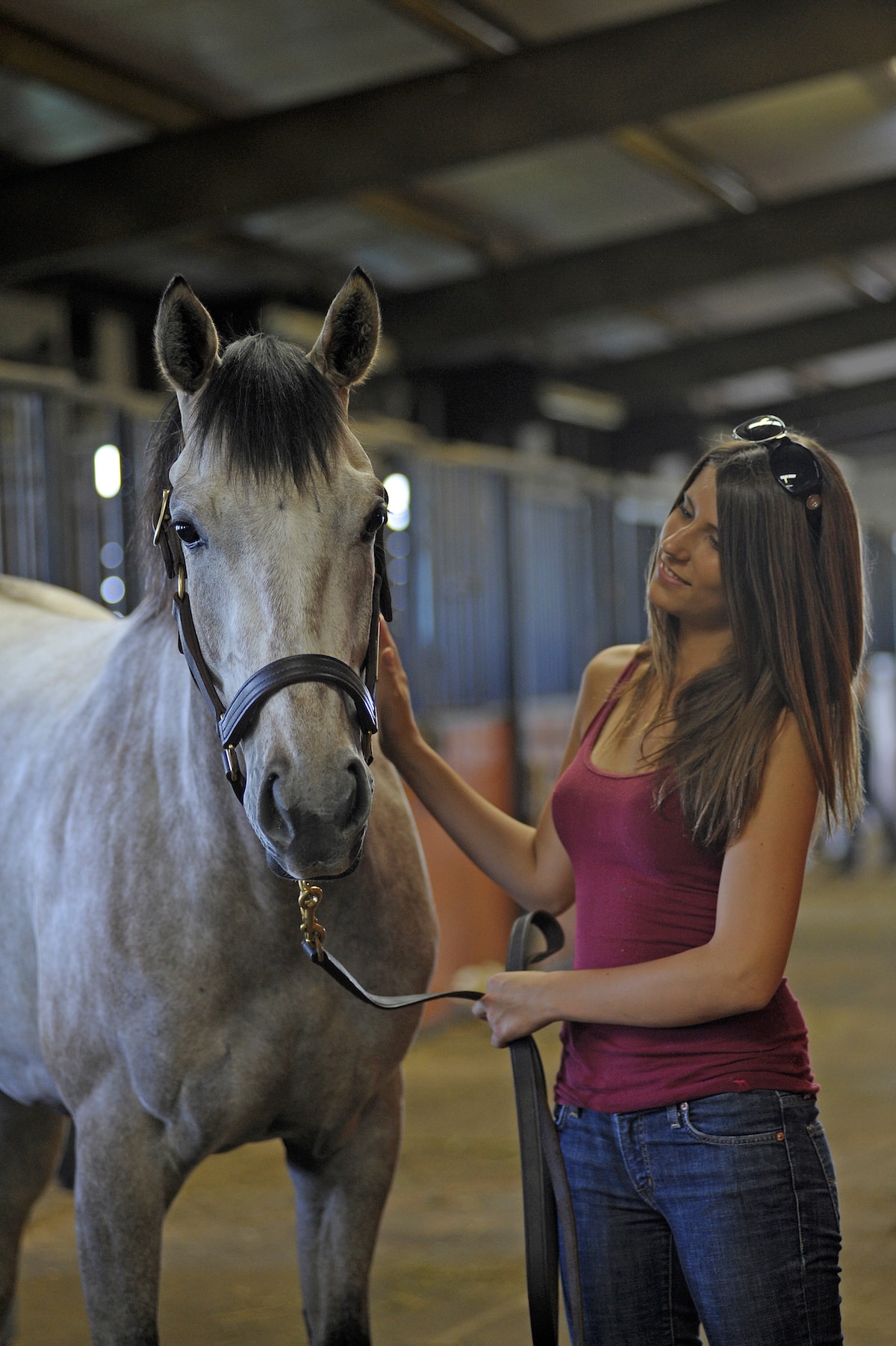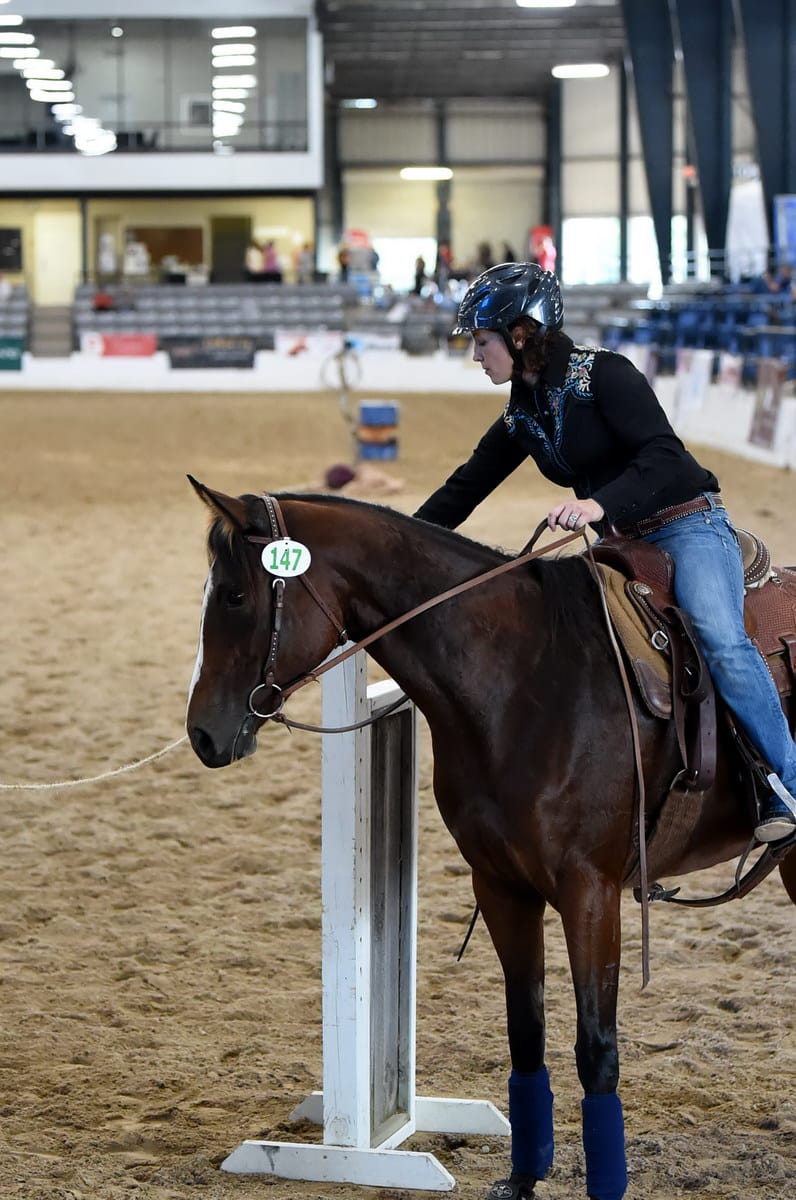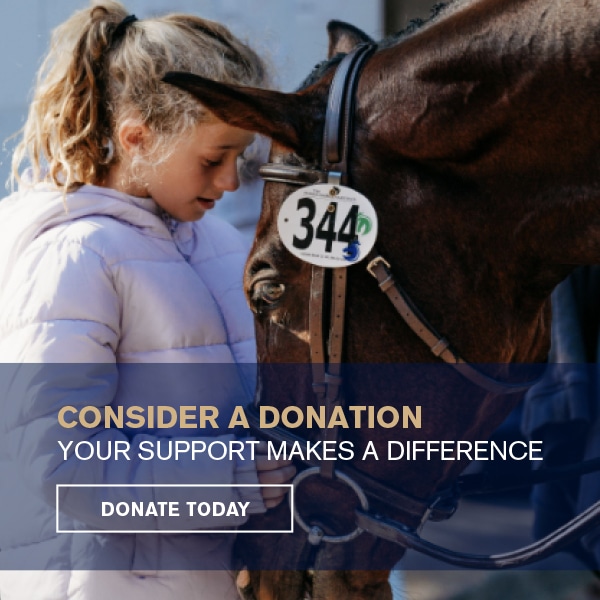From purchase price to routine care, find out what expenses you’ll likely encounter with your OTTB

Anne M. Eberhardt photo
Spoiler alert: Horses — especially our beloved OTTBs — cost us a lot. Time. Blood, sweat and tears. Nonhorsey social lives. Sanity. Dedication. Determination. Heart and soul. But we all know we wouldn’t have it any other way.
Of course, horses also cost money. You can probably get by without calculating the hours and heart you’ll invest in preparing a new prospect for his first show. But it’s considerably more difficult — and risky — to not budget for purchasing, maintaining and training a horse for an event like the Thoroughbred Makeover.
Whether you’ve retrained dozens of OTTBs or plan to check the “Compete in the Makeover” box on your equine bucket list, it never hurts to look at the numbers. We’ve consulted three Thoroughbred Makeover veterans to find out where they’ve spent their dollars in preparing for the “big dance” and even how they’ve recouped some expenses and saved a few pennies along the way.
Buying Your Horse
One of the most important decisions is how much you want to spend on an OTTB. There are many factors to consider, of course, but all purchasing plans must begin with a realistic budget.
Yes, the free or very inexpensive unicorns are out there. Yes, purchasing any horse (not just a low-priced one) is a risky investment. But don’t plan to find your next Grand Prix dressage horse or four-star eventer for a rock bottom price.
“If you’re going to get the free or $1, we always said, ‘You get what you get, and you don’t get upset,’ ” says Clare Mansmann, who runs Pacific Farms Inc., in Middleburg, Virginia, with her husband, Tom. “If you’re looking for something specific, you should be ready to pay more for that or spend more time looking. If you’re looking to just get something and see how it goes, you might be able to lower your price.”
Likewise, Alison Wilaby, a professional in Lexington, Kentucky, says it’s important to understand that the individuals who procure nice horses for free or at a comparatively low cost generally can do so because they’ve spent years fostering relationships with racing trainers and/or owners.
For example, Kasey Jackson, a lifelong equestrian and amateur trainer from Leechburg, Pennsylvania, bought her 2018 Makeover horse Psycho Kitty, or “Kat,” with whom she competed in Barrel Racing and Ranch Work, for well under $1,000.
“I was fortunate enough to have friends with track connections and have since developed a few of my own,” she says.
Another factor to consider in setting your budget is time, Mansmann says. Horses coming straight from the track sometimes benefit from a let-down period to help transition to their new lifestyle; many people source horses and allow this downtime before selling them.
“People tend to forget that you do not have to get your Makeover OTTB (or any of them) straight from the track,” she says. “There are many qualified trainers taking horses, transitioning them and then needing very much to sell them to keep producing these nice horses. People can certainly purchase these horses, where the feet and teeth have been rebalanced, the weight has been put on, the rehab done if it was needed and the early stages of new training that make it so you can hop on your horse and go for a ride.”
Such horses are often pricier — you might expect to pay around $4,500 for a horse that’s been sourced and is ready to go, Mansmann says.
Less-expensive horses coming straight from their race trainers often need more time before they’re ready to begin their retraining, she adds. It’s up to buyers how they build their budget: purchasing an already-let-down horse that’s ready to go for a higher price, or securing a more modestly priced horse that could need time off (while you’re still paying for daily care and board).
The bottom line is to set realistic expectations and know exactly what you’re looking for.
“If you want, specifically, an event horse, or if you want, specifically, a bay gelding with chrome, I think you need to really say, ‘OK, what’s that worth to me?’ and be ready to pay that,” Mansmann says.
For a sound English or Western sport horse prospect, Jackson says OTTB buyers in her area should expect to pay $1,500 to $4,000 straight off the track.
Likewise, Wilaby says, “I think $2,500 to $3,000 seems to be a price people are very comfortable with on the track, and you can get a decent horse.”
Of course, if you’re looking specifically for a resale project, Mansmann says it’s best to stay on the lower end of the spectrum to get the most bang for your buck.
“To get a $4,500 horse that you’re then going to resell — that’s going to have to be a pretty special horse,” she says. “You’re going to have to keep it longer and get a show record on it to actually make money on it.”
Prepurchase and Physical Exams
We’ve all learned to get a vet out for a prepurchase exam (PPE) before handing over any money, but the reality is this isn’t always easy when you’re buying horses off the track.
“Most of them are first-come, first-served,” Jackson says, with buyer demand leaving little time to schedule a PPE on short notice with your busy veterinarian.
There’s also the horse-price factor. If you’re lucky enough to find a free or very inexpensive horse, you might be willing to forego the extra expense.
“I knew the risk I was taking, but with the minimal investment I made (in buying Kat) I was willing to purchase without the PPE,” Jackson says.
Wilaby adds, “I don’t typically do prepurchases on free horses. Trainers look at you like, ‘This horse is free, are you kidding?’ But if I’m buying something for, say, $2,000, I’ll at least want a minimal prepurchase.”
Mansmann says, “It kind of depends on who the horse is coming from, how (well) we know them or if there are a lot of unknowns about the horse.”
Still, our sources advocate for investing in full exams for OTTBs, even if they’re conducted after purchase.
Wilaby says if she plans on keeping a horse to take to the Makeover or she’s looking to sell it for at least $10,000, she has her veterinarian conduct a full exam. She says she expects to pay $800 to $1,000 for full vettings, including X-rays.
And if something turns up on a prepurchase, Mansmann says, “It’s not so much that we won’t still take on the horse, it’s more just to know if the horse has any training limitations or (needs) time off … whatever the case may be.”
All three trainers also recommend having a new OTTB’s teeth examined and floated shortly upon arrival. Jackson says in her area this runs $110-150.

Trainers who find quality horses for free or cheap are usually those with racing connections. Kasey Jackson, for instance, bought Psycho Kitty (pictured) for well under $1,000 from her track contacts. Courtesy Kasey Jackson
Routine Expenses
Every horse has routine expenses you need to include in your budget.
Board If you own a farm, you don’t have to worry about boarding fees. But if you’ll need to board, find out the average rate for your area while budgeting.
“In our area, board runs easily between $350 to $600 per month,” Jackson says.
Wilaby keeps her horses on self-care board — she pays $250 per horse, per month, for a stall, supplies her own hay and grain and does all the work.
In Northern Virginia, Mansmann says a standard range for full-care board is $600-1,000 a month, and training board hovers around $1,800 per month.
Feed Wilaby’s grass hay costs $4.50 a bale, and her tri-fiber-based grain costs $17.50 per bag; she says her horses fresh off the track might eat up to 12 quarts per day. How many pounds of feed fill a quart varies, but it can range from ½ to 1½ pounds.
“I do spend a lot of money, early on, on grain to try to get them bigger, to help them put on some fat and muscle,” she says.
Mansmann says high-quality alfalfa represents a significant portion of her monthly feed budget. These large bales are close to $40 each, she says, and each horse tends to eat a bale a week while gaining weight and putting on muscle.
Jackson cautions owners against underbudgeting for feed, because Thoroughbreds don’t often carry weight as well as breeds like stock horses and Warmbloods.
“They’re like the people who can eat chocolate cake all day and not gain a pound,” she says. “Some of these horses are only 3 when they come off the track, and some can grow until they’re 6 or 7. That’s eating up calories. They’re healing. That’s eating up calories. You’re putting them into work. That’s eating up calories. They need a higher daily caloric intake.”
In addition, Jackson says her mare’s monthly supplements total $135.
Hoof Care Jackson, Mansmann and Wilaby agree that farriery is another important budget line when caring for horses coming off the track.
“If you’re only shoeing with front shoes, which is what I do for most green horses, my farrier is $135,” Wilaby says. “He might be pricier, but that’s my nonnegotiable — to have the best farrier I can. That’s where I spend my money. (The hooves are) the foundation of everything.”
Mansmann says a decent full set of shoes in her area runs $200 to $250. Jackson pays $45 for a trim or $145 for a full set of shoes.
“I do not think most people, especially those coming from the other breed associations, understand the maintenance that OTTB feet require or the time frame that getting their feet healthy can take,” Jackson says. “These horses come from a place where they are reset every three to four weeks with very light shoes.”
Our sources agree that a four- to five-week shoeing window is best for getting and keeping OTTB hooves stable and healthy.
“If you are used to a six- to eight-week week shoeing schedule, this can be quite the shock to the wallet,” Jackson says.
Health Your OTTB will need regular veterinary care, including appropriate vaccinations. Prices vary based on the number of vaccines your vet recommends, along with geographic region, so check with your local clinic for pricing.
Another consideration is internal parasite control. Work with your vet to assess your horse’s parasite shedding status with fecal egg counts and design a deworming regimen.
Consider that horses coming off the track might be dealing with gastric ulcers, which cost around $40-50 a day for upward of 14 to 28 days to treat.
Some horses might also benefit from complementary therapies. Jackson says she spends $75 to $150 on each massage and $50 on each pulsed electromagnetic field therapy (PEMF, used to stimulate cellular action, reduce pain and inflammation and hasten healing) session for her horses. Mansmann says she’s also had positive experiences with PEMF, which runs about $100 per treatment in her area.
Training Be it lessons or professional training, Jackson, Mansmann and Wilaby advocate for regular schooling as you’re bringing your OTTB along.
“Training sessions are always good because another set of eyes can see what you cannot or can confirm what you are feeling and help address why,” Jackson says.
“We highly recommend being ready to get your horse in a training program,” Mansmann says. “If everything’s going great, that’s great, but having the budget and knowing that if something goes wrong you have a budget for 30 to 60 days with a trainer — it can change everything.
“We see a lot of people want to do it on their own, but we don’t even do it on our own; it’s a team sport,” she adds. “You don’t have to have your horse in training for the rest of its life, but that transitional period is important.”
Jackson agrees, noting that in her area it costs $600-750 a month to send a horse to a barrel racing trainer.
Wilaby says lessons can also help keep horses healthy in the long run, as working correctly promotes proper muscle development and conditioning and reduces the risk of horses becoming sore due to improper schooling or movement.
Mansmann adds, “As you’re allocating funds, remember that a good training ride is going to help your horse’s musculoskeletal system, and a bad ride is going to damage it.”
In Jackson’s neck of the woods, lessons in varying disciplines are $45-100. In Northern Virginia, Mansmann says lessons typically run $75-100. Wilaby says her trainers in Central Kentucky (upper-level dressage and eventing riders) charge $80-100. But don’t fret if those prices are outside your comfort zone. Wilaby says up-and-coming trainers or those working on a smaller scale or at lower levels are generally less expensive but can still offer good help.
Unexpected Expenses
Be prepared for costs you don’t foresee. For instance, you might end up with a horse that’s hard to fit for a saddle. Wilaby says she uses different pads to help saddles fit well enough so she doesn’t have to purchase a new saddle for each horse she restarts. But that won’t work for all scenarios.
“Your saddle has to fit the horse,” Mansmann says. “It doesn’t have to be custom, but it has to fit both the horse and rider. Sometimes people find one that fits the horse, but it knocks their position out of whack. But that doesn’t benefit the horse either, because now the rider is in the wrong position.”
There are also unexpected veterinary expenses. Wilaby says her 2017 Makeover horse stepped on a shoe clip in the pasture two months before the event. While this doesn’t usually cause major problems, it turned into a near-disaster for her horse.
“He was nonweight-bearing on a front leg,” she says. “We had to take X-rays because we were worried about (bone or other) infection. We did antibiotics. Then he was really body sore everywhere else from compensating for that foot. We did a lot of chiropractic and acupuncture.”
Mansmann recalls what was expected to be a simple castration on a newly off-track Thoroughbred, who turned out to be a ridgling. This meant the veterinarian had to explore the horse’s body cavity to find an undescended testicle in a longer and more complex procedure.
Including a miscellaneous budget line for unexpected expenses and regularly contributing to an emergency fund savings account is never a bad idea.
Saving Money Without Cutting Corners
No, getting a horse to the Makeover isn’t cheap. But there are steps you can take to save a few pennies without sacrificing your horse’s health or well-being.
First, our sources agree you must spend money to save money.
“Not taking shortcuts winds up saving you money over time,” says Mansmann, such as ponying up for the best-quality forage and farriery.
Ordering supplies in bulk (you can split orders with other equestrians) and coordinating vet, farrier and therapist visits can help lower costs, too, Jackson says.
Wilaby says there are many free schooling opportunities in her area that riders can take advantage of to advance training progress.
“In a lot of cases you can take these horses to (local) shows for free,” she says. “Get your horse out there and in a show environment without spending money.”
And, Mansmann says, you can even put your OTTB to work for you. “We try to get the horses making a living,” in their lesson and training program or with a partial lease, she says. This arrangement can also help horses progress in their training.
“I think sometimes we get into wanting to do everything with the horse ourselves, and a lot of people don’t love other people getting on their horses,” Mansmann says. “But our job, as trainers, is to make them so anyone can get on them.”
The Bottom Line
The RRP estimates that a Makeover trainer spends an average of $8,000 to get a horse to the event. “When you get an OTTB, you’re buying a diamond in the rough,” says Jackson. “There’s a lot of polishing that needs to go on.”
By preparing a budget in advance and making smart spending decisions, you can make every dollar count toward getting your OTTB to the Makeover and beyond.
This article was originally published in the Winter 2019 issue of Off-Track Thoroughbred Magazine, the only publication dedicated to the Thoroughbred ex-racehorse in second careers. Want four information-packed issues a year delivered to your door or your favorite digital device? Subscribe now!

